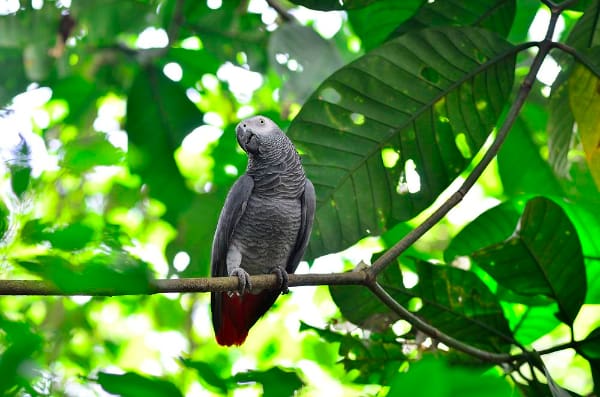Grey Parrots: Protection, Advocacy and Education
Since 2001, the WPT has been fighting to stop the trade in Grey Parrots (Psittacus erithacus). In 2016, collaboration with field partners produced new data that, along with a 75,000-signature petition, were presented at the Conference of the Parties for CITES 17. Delegates voted to transfer Grey Parrots to Appendix I, ending their commercial trade. Working with various partners, WPT has also convinced airlines to boost protections against trafficking, working with Turkish Airlines to finalise an embargo on transporting Grey Parrots and improve training for officials in vulnerable trafficking sites.
Kibale National Park is a protected area in Uganda. Grey Parrots, which reside here, will sometimes leave the safety of the park to forage on the area’s edge. One of the main threats to the parrots is tree-cutting for firewood and charcoal, and creating agricultural land. Naturalist Nick Byaba, working with In the Shadow of Chimpanzees NGO, has talked to farmers and has successfully stopped some of them from cutting important parrot trees. In 2022, Byaba formed the Parrot Tree Caretakers Association which unites local farmers to protect and plant trees that parrots feed on.
IUCN/CITES Status: Endangered / Appendix I
Population: As few as 560,000, decreasing.
Range: Grey Parrots are found in S Nigeria, S Central African Republic, Republic of Congo, DRC, Gabon, Equatorial Guinea, SE Ivory Coast, N Angola, S Democratic Republic of Congo, NW Tanzania, W Kenya, W Uganda, Principe and Bioko Islands.
Natural history: Seen in primary and secondary rainforest, clearings, mangroves, wooded savanna, cultivated land and gardens to an altitude of 2200 m (7216 ft). Diet includes fruits and seeds, particularly oil palm fruit. Flocks roost in palms over water or on islands in rivers. Breeding is January-February and June-July, E Africa; in other areas the dry season. Nest is a cavity in a tall living tree.

